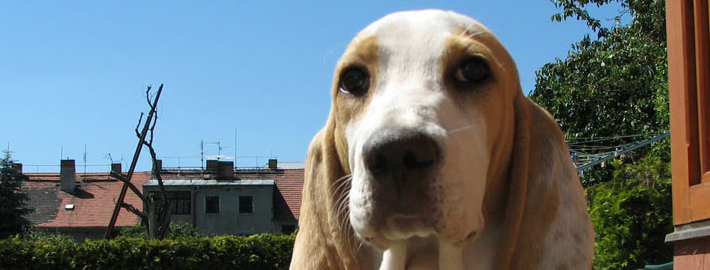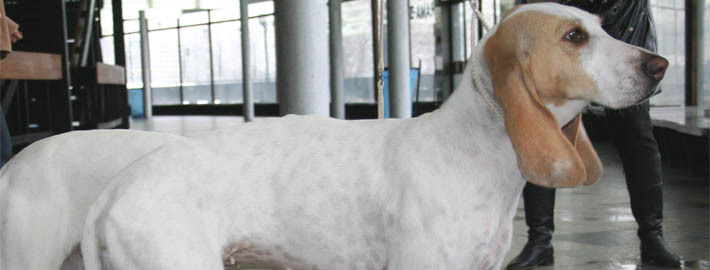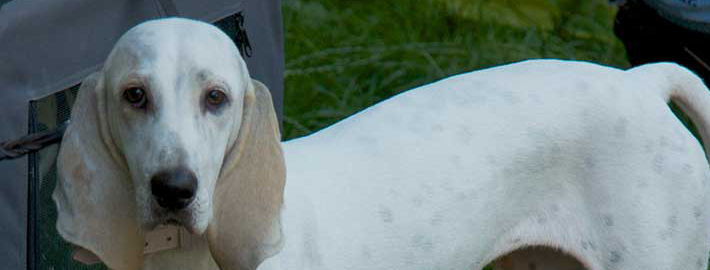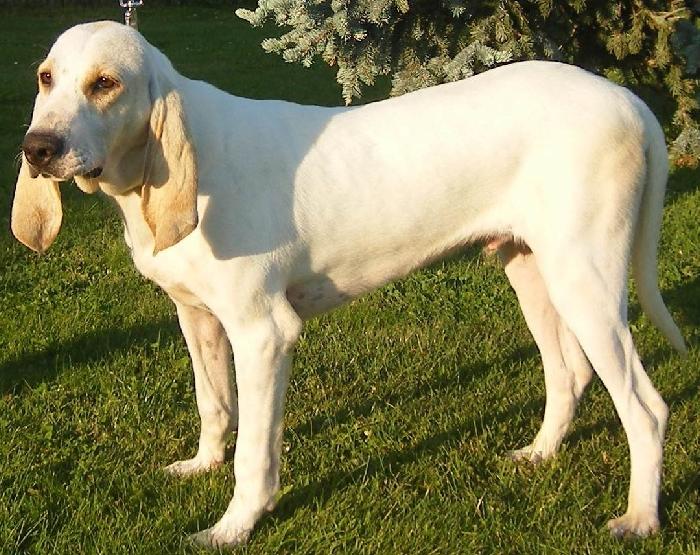What makes the Porcelaine Unique?
These gundogs disappeared during the French Revolution in their homeland, but have since been recreated by breed enthusiasts. Their current range is mostly limited to the United Kingdom and parts of Continental Europe but they have been gaining popularity in other regions.
Breed Groups
Page Contents
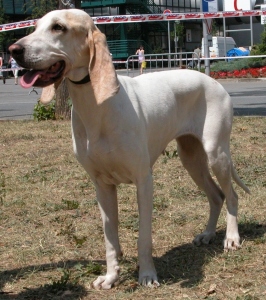
SnapShot
| Size: | Males – 22-23 inches (56-58 cm) Females – 21-22 inches (53-56 cm) |
| Weight: | Males – 55-62 pounds (25-28 kg) Females – 55-62 pounds (25-28 kg) |
| Origin: | France |
| Life Span: | 12-13 years |
| Colour: | Orange mantle. Orange color too dark (mahogany), or light (faded to lemon). Intermingled gray or black hairs in the coat. |
| Litter Size: |
Is the Porcelaine Right For You?
Members of this breed are devoted to their humans and they are particularly good with children. Porcelaines are accepting of other dogs but should not be left unsupervised around cats or other small pets as they may chase and possibly injure them. Although Porcelaines are quite tenacious in the field, these dogs are well-behaved and placid indoors as long as they receive plenty of exercise. Prospective owners should note that these dogs are prone to separation anxiety if they are left by themselves for extended periods of time. This can result in pets howling loudly and/or becoming destructive when left unattended. Therefore, this isn’t the breed for someone that doesn’t want a clingy pet. Likewise, members of this breed are not recommended for apartment dwellers due to their loud howls and their energetic natures. These dogs instead prefer rural life.
In 5 Words
- Gentle
- Energetic
- Active
- Willful
- Quite
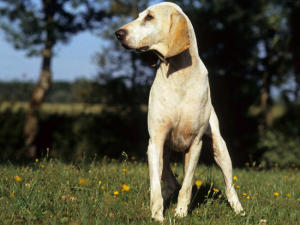
Characteristics
Learn About the Porcelaine
Description
General Description
These dogs derive their name from slightly transparent coats that are thought to resemble enameled porcelain. Members of this breed should have black noses and eyes, as light colored eyes and different colored noses are considered to be serious breed flaws. These should display a sweet and intelligent expression. Porcelaines have long, thin, drooping ears with pointed tips. Narrow necks, lengthy heads, wide skulls, and flat foreheads are other breed features. Their chests are wide and they have sloping hips. They have broad loins and backs. Porcelaines also have elongated limbs and cat-like feet. They should walk at a lively pace. Members of this breed also possess medium length, curved tails that are thick at the base and taper to a point.
Size
Males of this breed stand from 55 to 58 centimeters (21.7 to 22.8 inches) at their withers. Female dogs are somewhat shorter at 53 to 56 centimeters (21 to 22 inches) in height. Canines of both genders should weigh approximately 28 kilograms (61.8 pounds). It is considered a fault for Porcelaines to be either larger or smaller than the breed standard.
Coat
These dogs possess a close-fitting coat that is thick and shiny. Their fur is typically white with orange spots that lend it a transparent look when they overlay black areas of skin. Orange spots are typically also present on a dog’s ears. The United Kennel Club considers it a serious fault if these dogs have coarse, thick coats or long fur on their tails. Albino dogs are not allowed in the show ring.
Short History of the Porcelaine
Porcelaines have ancestry that includes French scent hounds, Swiss Laufhounds, English Harriers, and the currently extinct Montemboeuf. It is even thought that Porcelaines have been in existence since the 1600s. However, the documented evidence of this breed only dates as far back as 1845 in France and 1800 in Switzerland. In the centuries that followed their creation, Porcelaines were kept as pets by monks and aristocrats. Although the French Revolution decimated these dogs along with the members of the clergy and the nobility to which they belonged, a number of the animals managed to escape over the border to Switzerland. Some Porcelaines even migrated to Louisiana with their owners. It is speculated that the descendants of those canines imported to the States became part of the local Native American breeds. Porcelaines were eventually recreated as a breed once the chaos in France had died down. These dogs were officially recognized by the United Kennel Club in 1996. Today, these rare dogs are commonly used in their homeland for hunting deer, rabbits, and boar. They also go by the names of Franché-Comté and Lunéville hounds.
Temperament
Porcelaines are easy-going, sweet tempered, and social. The United Kennel Club considers extreme shyness or viciousness to be a serious flaw in this breed. These friendly dogs adore people and want nothing more than their attention, which makes them great companions. Members of this breed are devoted to their humans and they are particularly good with children. Porcelaines are accepting of other dogs but should not be left unsupervised around cats or other small pets as they may chase and possibly injure them. Although Porcelaines are quite tenacious in the field, these dogs are well-behaved and placid indoors as long as they receive plenty of exercise. Prospective owners should note that these dogs are prone to separation anxiety if they are left by themselves for extended periods of time. This can result in pets howling loudly and/or becoming destructive when left unattended. Therefore, this isn’t the breed for someone that doesn’t want a clingy pet. Likewise, members of this breed are not recommended for apartment dwellers due to their loud howls and their energetic natures. These dogs instead prefer rural life.
Caring for Your Porcelaine
General Health
Porcelaines typically live between 12 and 13 years. No specific health conditions have been noticed in these dogs. However, as is the case with any breed, various problems can arise from time to time.
Care
Daily
These dogs require copious amounts of exercise. They will need to be taken out on a long walk or jog every day.
Weekly
It is also a good idea to cleanse a dog’s teeth at least a few times per week to prevent both bad breath and periodontal disease. Brushing Porcelaines a few times per week is also recommended as this practice will keep households from becoming inundated with fur.
Monthly
Parasite prevention medication is a must for all pets and these products are typically used once a month.
Grooming & Bathing
Porcelaines do not require a lot of grooming since their short coats shed dirt easily. However, owners will need to check the dogs over for injuries when they return from hunting excursions and treat them accordingly. Foreign materials occasionally get stuck in a dog’s feet or ears, which may necessitate cleaning the affected area, and sometimes ticks will need to be removed after a hunting trip. In any case, their ears should be cleansed regularly with a vet approved product.
Exercise & Training
Porcelaines are tireless hunters that traditionally ran in packs. Members of this breed have a strong sense of smell and a melodious voice. They can be somewhat difficult to train but are nonetheless good at their original job. After all, these dogs are not intimidated even by wild boars. This breed is best for experienced dog owners as they require a firm but gentle hand. Porcelaines have tendency to be stubborn and independent. While they may not always follow the first command that is given, Porcelaines nonetheless benefit from positive, consistent training methods. When out walking, these dogs should not be allowed to pull or tug at their leashes, because this can lead to confusion as to who precisely is the leader. They should instead walk beside the human that is accompanying them.

